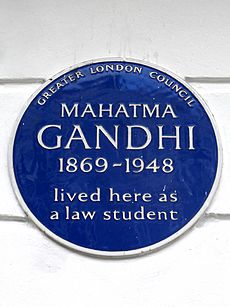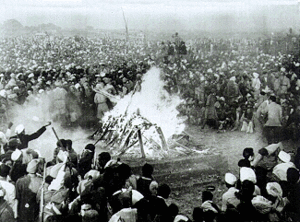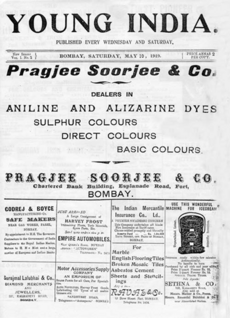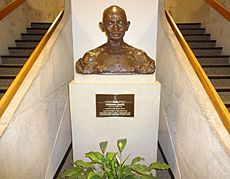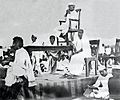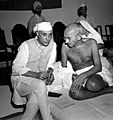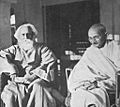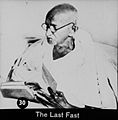Mahatma Gandhi facts for kids
Quick facts for kids
Mahātmā
Gandhi
|
|
|---|---|
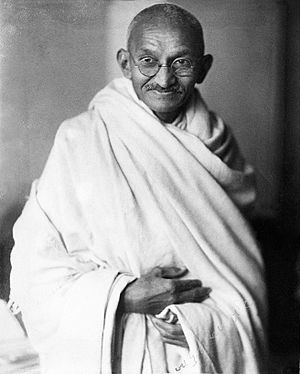
Gandhi in London, 1931
|
|
| Born |
Mohandas Karamchand Gandhi
2 October 1869 Porbandar, Porbandar State, Kathiawar Agency, British Raj
|
| Died | 30 January 1948 (aged 78) |
| Cause of death | Assassination |
| Monuments |
|
| Citizenship |
|
| Alma mater |
|
| Occupation |
|
| Years active | 1893–1948 |
| Era | British Raj |
| Known for |
|
|
Notable work
|
The Story of My Experiments with Truth |
| Political party | Indian National Congress (1920–1934) |
| Movement | Indian independence movement |
| Spouse(s) | |
| Children |
|
| Parents |
|
| Relatives | See Family of Mahatma Gandhi C. Rajagopalachari (father-in-law of Gandhi's son Devdas) |
| Awards | Time Person of the Year (1930) |
| 43rd President of the Indian National Congress | |
| In office 1924-1925 |
|
| Preceded by | Abul Kalam Azad |
| Succeeded by | Sarojini Naidu |
| Signature | |
 |
|
Mohandas Karamchand Gandhi ( GA(H)N-dee 2 October 1869 – 30 January 1948) was an Indian lawyer and leader. He is famous for using nonviolent resistance to help India gain independence from British rule. His methods inspired many civil rights movements around the world. People often call him Mahātmā, which means "great-souled" or "venerable". This special name was first given to him in 1914 in South Africa.
Contents
- Gandhi's Early Life and Education
- Life and Activism in South Africa
- Gandhi's Return to India and Political Leadership
- India's Independence and Partition
- Gandhi's Philosophy of Nonviolence
- Gandhi's Funeral and Memorials
- Gandhi's Personal Life
- Interesting Facts About Mahatma Gandhi
- Mahatma Gandhi Quotes
- Gandhi's Legacy and Influence
- Gandhi's Writings
- Gandhi's Followers and Global Impact
- Awards and Honors for Gandhi
- Gandhi's Impact in India Today
- Gandhi's Family Today
- Images for kids
- See also
Gandhi's Early Life and Education
Mohandas Karamchand Gandhi was born on October 2, 1869. His family was from a Hindu community in Porbandar, a coastal town in Gujarat, India. His father, Karamchand Uttamchand Gandhi, was the chief minister of Porbandar state.
When he was nine, Gandhi started school in Rajkot. He learned math, history, and geography. At age 11, he went to Alfred High School. He was an average student, quite shy, and loved reading books. He wasn't very interested in sports or games.
In 1887, at 18, Gandhi finished high school. He briefly attended Samaldas College but decided to drop out. A family friend suggested he study law in London.
Gandhi left for London at 18 to study law. He trained at the Inner Temple and became a lawyer in 1891. After two difficult years trying to start a law practice in India, he moved to South Africa in 1893. He went there to help an Indian merchant with a legal case.
Life and Activism in South Africa
Gandhi lived in South Africa for 21 years. During this time, he started his family. He also began to use nonviolent resistance to fight for civil rights.
When Gandhi arrived in South Africa, he faced a lot of discrimination because he was Indian. He was not allowed to sit with European passengers on a stagecoach. He was even thrown off a train for refusing to leave the first-class section. A court in Durban ordered him to remove his turban, but he refused. Indians were also not allowed to walk on public sidewalks. Gandhi was once kicked off a sidewalk by a police officer.
These experiences made Gandhi realize the unfairness of racial discrimination. He began to focus on the rights of Indians. Later, his newspaper, Indian Opinion, also reported on discrimination against Africans. Years later, after black South Africans gained voting rights, Gandhi was honored as a national hero in South Africa.
Gandhi's Return to India and Political Leadership
In 1915, at 45, Gandhi returned to India. People were drawn to him because he understood their struggles. He quickly began organizing farmers and workers to protest unfair land taxes and discrimination.
In 1921, Gandhi became the leader of the Indian National Congress. He led campaigns to help the poor, support women's rights, and promote peace between different religions. He also worked to end the practice of "untouchability." Most importantly, he fought for swaraj, or self-rule, for India.
Gandhi started wearing a simple dhoti made from hand-spun yarn. This showed his connection to India's poor villagers. He lived in a simple community and often fasted as a way to protest and reflect.
In 1930, Gandhi led the famous Salt March. He walked 400 km (250 mi) to the sea to make salt. This was a protest against the British tax on salt. In 1942, he called for the British to "Quit India" and leave the country. He was arrested many times in both South Africa and India for his activism.
India's Independence and Partition
Gandhi wanted an independent India where all religions could live together peacefully. However, in the 1940s, some Muslims wanted a separate country. In August 1947, Britain granted India independence. But British India was divided into two countries: India (mostly Hindu) and Pakistan (mostly Muslim).
This division led to terrible violence between Hindus, Muslims, and Sikhs. Gandhi visited the affected areas to try and bring peace. He went on several hunger strikes to stop the violence. His last fast, in January 1948, also aimed to pressure India to pay money owed to Pakistan.
Some Hindus in India believed Gandhi was too supportive of Pakistan and Indian Muslims. One of these was Nathuram Godse. On January 30, 1948, Godse assassinated Gandhi in Delhi.
Gandhi's Philosophy of Nonviolence

Gandhi did not invent the idea of nonviolence, but he was the first to use it widely in politics. The idea of nonviolence (ahimsa) has a long history in Indian religions. It is seen as a very important ethical value. Gandhi wrote about his ideas on ahimsa in his autobiography, The Story of My Experiments with Truth.
Gandhi's Funeral and Memorials
Gandhi's death was a huge loss for India. Over a million people joined his five-mile-long funeral procession. It took over five hours to reach Raj Ghat, where he was cremated. His body was carried on a special vehicle pulled by 50 people.
Gandhi was cremated according to Hindu traditions. His ashes were placed in urns and sent across India for memorial services. Most of his ashes were scattered in the Sangam at Allahabad river on February 12, 1948.
The place where Gandhi was assassinated is now a memorial called Gandhi Smriti. The spot where he was cremated is the Rāj Ghāt memorial in New Delhi. It has a black marble platform with the words "Hē Rāma" (Hey Raam). These are believed to be Gandhi's last words.
Gandhi's Personal Life
In May 1883, at 13, Mohandas married 14-year-old Kasturbai Makhanji Kapadia. This was an arranged marriage, common at the time. He once said, "As we didn't know much about marriage, for us it meant only wearing new clothes, eating sweets and playing with relatives."
In 1885, Gandhi's father died. Gandhi, then 16, and Kasturba, 17, had their first baby, who sadly lived only a few days. These two deaths deeply saddened Gandhi. The couple later had four more sons: Harilal (born 1888), Manilal (born 1892), Ramdas (born 1897), and Devdas (born 1900).
Interesting Facts About Mahatma Gandhi
- Mahātmā is a title, not his first name. It means "great-souled" or "venerable."
- As a child, Gandhi was described as "restless as mercury." He loved playing and exploring.
- Indian stories like those of Shravana and King Harishchandra greatly influenced him.
- In India, Gandhi is known as the Father of the Nation. People often call him Bapu, which means 'father' or 'papa' in Gujarati.
- Nelson Mandela, who fought against racism in Africa, admired Gandhi's work.
- Winston Churchill was a strong critic of Gandhi and opposed his plans for India.
- Gandhi exchanged letters with the Russian writer Leo Tolstoy about nonviolence. Gandhi saw himself as a student of Tolstoy.
- The Mahatma Gandhi District in Houston, Texas, is named after him.
- Indira Gandhi, a former Prime Minister of India, was not related to Mahatma Gandhi.
- Gandhi was nominated for the Nobel Peace Prize five times but never received it.
Mahatma Gandhi Quotes
- "There are two days in the year that we can not do anything, yesterday and tomorrow."
- "It's easy to stand in the crowd but it takes courage to stand alone."
- "If you want to change the world, start with yourself."
- "Live as if you were to die tomorrow. Learn as if you were to live forever."
- "Forgive and forget, but never forget to forgive. You may find a happier heart is the key to a happier life."
- "Speed is irrelevant if you are going in the wrong direction."
- "Peace is the most powerful weapon of mankind."
Gandhi's Legacy and Influence
Gandhi's birthday, October 2, is a national holiday in India called Gandhi Jayanti. It is also celebrated worldwide as the International Day of Nonviolence.
Gandhi is seen as the most important figure in India's successful fight for independence. He is also considered the greatest Indian leader of modern times. Historians have called him "India's greatest revolutionary nationalist leader." In 1999, Asiaweek named him "Asian of the century." A 2000 BBC poll voted him the greatest man of the millennium.
The word Mahatma comes from Sanskrit words meaning "Great Soul." He was given this title in 1914. Many believe poet Rabindranath Tagore gave him the title by 1915. However, Gandhi himself said he never truly valued the title.
Many streets and places in India are named after Gandhi. These include M.G. Road in many cities and Gandhinagar, the capital of his home state, Gujarat.
Over 150 countries have released stamps honoring Gandhi. In 2019, about 87 countries issued stamps for his 150th birth anniversary. An asteroid, 120461 Gandhi, was named after him in 2020. In 2022, a statue of Gandhi was put up at the United Nations Headquarters in New York.
Gandhi's Writings
Gandhi was a very active writer. His writing style was simple and clear. One of his first books, Hind Swaraj (1909), became a guide for India's independence movement. He edited several newspapers, including Indian Opinion in South Africa and Young India and Navajivan in India. He also wrote letters almost every day.
Gandhi wrote several books, including his autobiography, The Story of My Experiments with Truth. He also wrote Satyagraha in South Africa about his struggles there. He wrote about vegetarianism, health, religion, and social reforms. He usually wrote in Gujarati, but his books were also translated into Hindi and English.
Gandhi's Followers and Global Impact
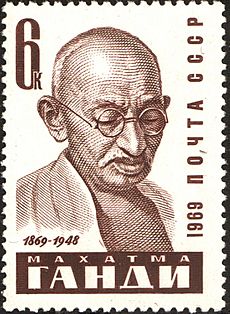
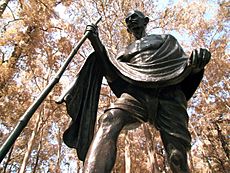
Gandhi influenced many important leaders and movements. Leaders of the Civil Rights Movement in the United States, like Martin Luther King Jr., learned from Gandhi's ideas about nonviolence. King said, "Christ gave us the goals and Mahatma Gandhi the tactics."
Nelson Mandela, who fought against Apartheid in South Africa, was also inspired by Gandhi.
Many people saw Gandhi as their teacher and dedicated their lives to spreading his ideas. In 1931, physicist Albert Einstein exchanged letters with Gandhi. Einstein called him "a role model for the generations to come." The musician John Lennon also spoke about Gandhi's views on nonviolence.
Time magazine called leaders like The 14th Dalai Lama, Martin Luther King Jr., and Nelson Mandela "Children of Gandhi." This showed they were his spiritual followers in nonviolence. Gandhi's ideas have also influenced modern thinking on environmental issues.
Awards and Honors for Gandhi
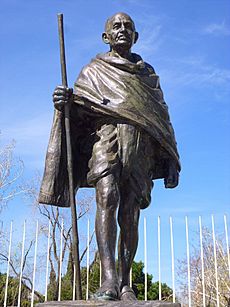
Time magazine named Gandhi the Man of the Year in 1930. In 1999, Time listed him as the second most important person of the century, after Albert Einstein. The University of Nagpur gave him an honorary law degree in 1937.
The Government of India gives out the annual Gandhi Peace Prize to important social workers and world leaders. Nelson Mandela was a famous non-Indian who received this award. In 2011, Gandhi topped Time's list of the top 25 political icons of all time.
When the 14th Dalai Lama received the Nobel Peace Prize in 1989, the committee said it was partly a tribute to Gandhi.
Gandhi's Impact in India Today
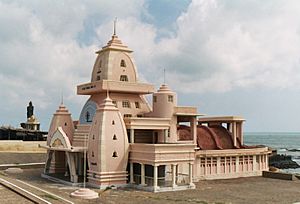
Modern India has moved away from some of Gandhi's economic ideas. However, it has embraced much of his political vision. India still deeply respects his memory. He is credited with shaping India's identity as a tolerant, secular democracy.
Gandhi's birthday, October 2, is a national holiday in India. His image is on all Indian paper money except the one-rupee note. January 30, the day he died, is remembered as Martyrs' Day in India.
There are three temples in India dedicated to Gandhi. The Gandhi Memorial in Kanyakumari looks like a traditional Hindu temple. The Tamukkam Palace in Madurai now houses the Mahatma Gandhi Museum.
Gandhi's Family Today
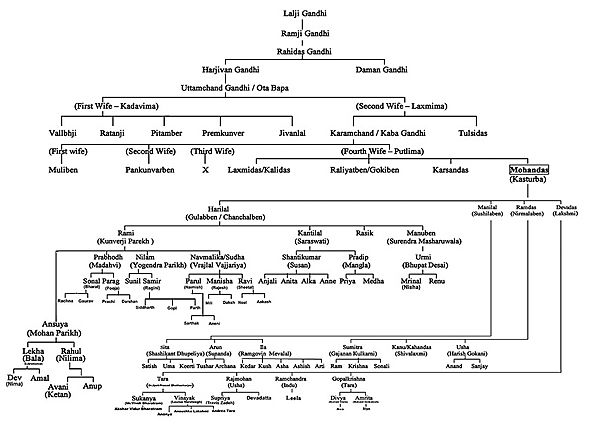
Gandhi's children and grandchildren live in India and other countries. His grandson Rajmohan Gandhi is a professor and author of a book about Gandhi. Another grandson, Tarun Gandhi, has also written books about his grandfather.
Images for kids
-
Bronze statue of Gandhi in Pietermaritzburg, South Africa, unveiled in 1993.
-
Gandhi with the stretcher-bearers of the Indian Ambulance Corps during the Boer War.
-
Gandhi and his wife Kasturba in 1902.
-
Gandhi with Dr. Annie Besant in Madras in September 1921.
-
Gandhi's first visit to Odisha in 1921.
-
Gandhi and his personal assistant Mahadev Desai at Birla House, 1939.
-
An admiring crowd gathers to see Mahatma Gandhi in the East End of London, 1931.
-
Gandhi talking with Jawaharlal Nehru during the drafting of the Quit India Resolution in Bombay, August 1942.
-
Gandhi in 1942, the year he launched the Quit India Movement.
-
Gandhi with Muhammad Ali Jinnah in September 1944.
-
Gandhi in 1947, with Louis Mountbatten, Britain's last Viceroy of India, and his wife Edwina Mountbatten.
-
Gandhi with poet Rabindranath Tagore, 1940.
-
"God is truth. The way to truth lies through ahimsa (nonviolence)" – Sabarmati, 13 March 1927.
-
Gandhi picking salt during Salt Satyagraha to defy colonial law.
See also
 In Spanish: Mahatma Gandhi para niños
In Spanish: Mahatma Gandhi para niños



